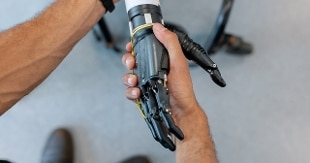Artificial intelligence, the EU dictates the rules but admits facial recognition
Pope praises next generation Eu: "Example of solidarity"
The Vatican brings together world experts on the ethics of artificial intelligence
Artificial intelligence, the EU aims to become the third pole
Artificial intelligence, the first doctorate in Italy is underway
Share
21 April 2021 The European Commission presents in Brussels the proposal for new rules and actions with a very ambitious goal: to transform Europe into the world hub for
reliable artificial intelligence
.
Von der Leyen: high standards
Artificial intelligence is a fantastic opportunity for Europe. And citizens deserve technologies they can trust. Today we present new rules for reliable Al. They set high standards based on different levels of risk. "The President of the European Commission, Ursula von der Leyen writes in a tweet." Today we are also presenting a coordinated plan, to outline the reforms and investments we need to ensure the our position as a leader in AI, worldwide. With almost € 150 billion in digital investments - 20% of the budget - Next Generation Eu will help strengthen the excellence in AI in the European Union, "he explains.
The proposal for reliable artificial intelligence
To do this, the Commission has prepared the first legal framework on AI ever created in Europe, and a plan - coordinated with the Member States - to guarantee the safety and fundamental rights of citizens and businesses, which at the same time reinforces the adoption of AI and investment and innovation in the sector across the EU. "We want a reliable AI", Commissioner Margrethe Vestager writes on Twitter, "for health, the fight against climate change, everyday life, if we can trust that it does not jeopardize our fundamental rights", explaining the meaning of the proposal
We want to use more #TrustworthyAI! For health, fighting climate change, convenience in everyday life -if we can trust #AI not to put our fundamental rights at risk. This is today's proposal - and that we become excellent in developing #TrustworthyAI https://t.co/eocNIph1TN
- Margrethe Vestager (@vestager) April 21, 2021
The four levels of risk
The new rules will be applied everywhere in the EU, with an approach based on the level of risk.
Unacceptable risk
: AI-based systems considered a clear threat to security, livelihoods and people's rights will be banned. This includes AI systems or applications that manipulate human behavior to circumvent users' free will (for example, toys that use voice assistance to encourage unsafe behavior by minors) and systems that allow governments to attribute a " social score ".
High risk
: This category includes systems in which AI technology is used and which will be subject to strict obligations before they can be placed on the market:
Critical infrastructures (e.g.
transport
), as it could endanger the life and health of citizens ;
Vocational education or training
, as it can determine a person's access to education and career path in life (for example, scoring exams);
Product safety
components
(e.g. an AI application used in robot-assisted surgery);
Employment,
worker management
and access to self-employment (for example, software for selecting curricula for recruitment procedures);
Essential
public
and private services (for example, 'scoring' or credit score which can see citizens denied the possibility of obtaining a loan);
Activities that may interfere with
people's
fundamental rights
(for example, assessing the reliability of evidence);
Management of
migrants
, asylum and border control (e.g. verification of the authenticity of travel documents);
Administration of
justice
and democratic processes (for example, application of the law to a concrete set of facts).
Then there are systems with
limited risk
, such as chatbots, with specific transparency obligations (users should be aware of the fact that they are interacting with a machine) and systems with
minimal risk
: such as applications such as video games or spam filters based on AI. According to the Commission, the
vast majority of AI systems
fall into this category, so the draft regulation does not intervene in this case.
Biometric recognition remains a high risk
No ban or moratorium on artificial intelligence systems based on citizens' biometric data, even if all
remote biometric identification systems
they are considered to be high risk and subject to stringent requirements.
Their use in real time for law enforcement purposes in
spaces accessible to the public
is in principle prohibited. There are few strictly defined and regulated exceptions (for example, where strictly necessary to search for a
missing child
, prevent a
specific and imminent
terrorist threat,
or identify, locate, identify or prosecute perpetrators or suspects of a
serious crime
). In these cases the use is subject to the
authorization
of a judicial or other independent body, with limits regarding the
time
, geographical scope and
databases
.
Finally Thierry Breton, Commissioner for the Internal Market, recalled that "AI is
a means, not an end
. It has existed for decades, but new capabilities powered by computing power are now possible. This offers enormous potential in many different sectors. including health, transport, energy, agriculture, tourism or cybersecurity, but it also presents a number of risks. Today's proposals aim to strengthen Europe's position as a global center of excellence in AI from laboratories to the market, to ensure that AI in Europe respects our values and rules and to exploit the potential of AI for industrial use. "
The European Parliament and the Member States will have to adopt the Commission's proposals under the
ordinary legislative procedure
. Once adopted, the regulations will be directly applicable across the EU.

